This post may contain affiliate links. Please read our affiliate disclosure.
This homemade bug-repellent spray is made with essential oils and is very effective without any toxic chemicals.
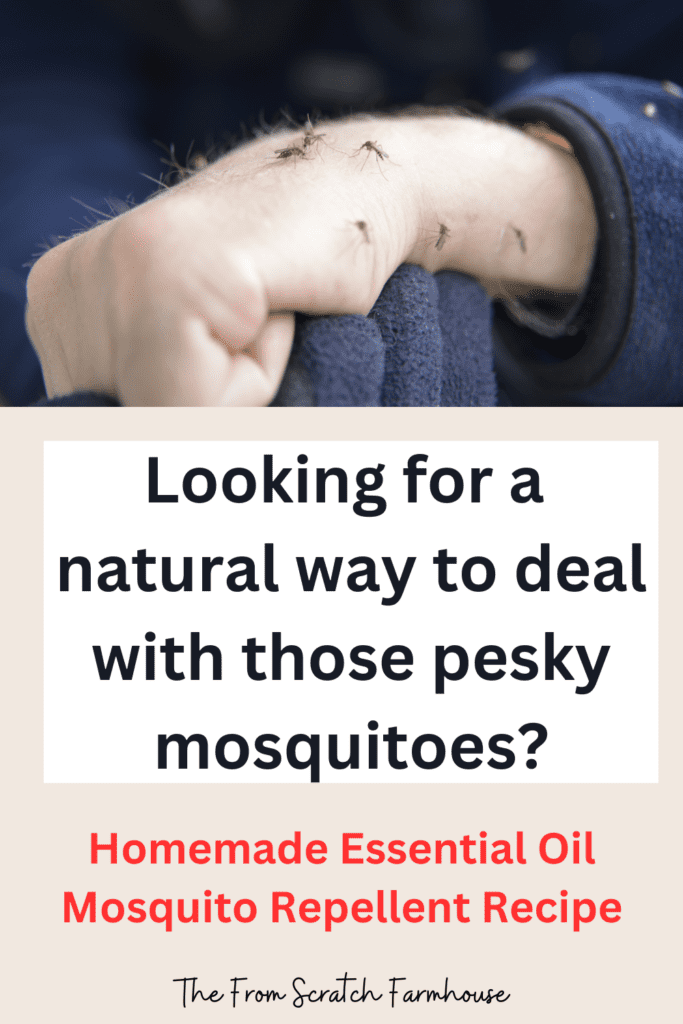
Have you ever met someone who seems to attract every mosquito within a 1-mile radius? Well, I am that person! While my friends and family members can be sitting outside enjoying a nice summer BBQ, I’ve been known to douse myself in chemicals and still end the night eaten alive. It’s awful.
During my first pregnancy, I become more aware of the risks of chemicals and sought to find natural alternatives. I think I tried every natural bug spray on the market that year!
Some smelled horrible. Others turned out to just contain lesser-known toxins. Some were not effective at all as natural repellents.
The good news is that, after significant research, I have found a recipe for natural bug repellent. This homemade bug repellent is effective, uses an essential oil blend as the active ingredient, doesn’t cause skin irritation, and is safe for keeping a variety of pesky bugs away from both young children and pregnant people as well!
This recipe is also easy to mix up and includes just a few easy-to-find ingredients. Nowadays, even essential oils can often be found locally.
Our family is currently writing up our summer bucket list as I write this. Living in a location where we have snow on the ground 7-8 months out of the year, we really look forward to this time of year! So far we have a camping trip, floating down the river, swimming at the lake, and a lot of family hikes on the list. As soon as our cold weather turns warm, I will be whipping up a batch of this spray so that our family adventures are not ruined by itchy mosquito bites or other insect bites that can cause allergic reactions or illness.
This post may contain affiliate links. If you choose to purchase through these links I may make a small commission at no extra charge to you.
How To Make Homemade Bug Spray With Essential Oils
Ingredients you’ll need for this recipe
What brand is best for essential oils?
The most popular essential oil companies are MLMs such as Young Living and Doterra. However, many people, including myself, would rather not purchase from an MLM. There are many other high-quality brands on the market. I personally suggest buying organic essential oils from Plant Therapy. They are high quality, certified organic, and affordable!
Do I really need to use bug spray? Why are bug bites dangerous?
Aside from the fact that itchy bug bites are annoying and uncomfortable, insects can also carry many serious diseases. Mosquitoes carry West Nile virus, Malaria, among others. Ticks can carry Lyme disease, Rocky Mountain Spotted Fever, and many other diseases that can have life-altering consequences. In countries outside of the US, there are diseases such as yellow fever and Zika virus that can be carried by mosquitos and lead to death.
Did you know?
Mosquitos are the world’s deadliest animal. They are believed to cause around 1 million deaths each year!
How to Make Homemade Bug Spray Repellent
- Step One: To a 4 oz. bottle, add 2 oz. of witch hazel (I just estimate about halfway up the bottle).
- Step Two: Add ½ tsp. vegetable glycerin.
- Step Three: Add the essential oils of your choice.
- Step Four: Fill the rest of the bottle with distilled water, leaving enough space at the top to shake the mixture.
- Step Five: Screw the top on tightly and give it a good shake.
- Step Six: Shake before using. Spray onto clothing, near doorways and windows, and where mosquitoes and ticks may access the skin.
Find the measurements and full recipe below!
What other essential oils repel bugs?
While I love the combination of oils in my signature recipe, you can also mix them up to your personal preferences or the particular bugs you are looking to repel. Here are some other oils that you can use to create your perfect bug-repellent recipes.
Best essential oils for repelling mosquitoes:
Best essential oils for repelling ticks and other insects:
Why it Works
The essential oils used in this bug spray recipe are all known for their insect-repelling properties. Citronella and lemongrass, in particular, are commonly used in commercial bug sprays. Peppermint and lavender also have insect-repelling properties and can help soothe bug bites.
Witch hazel is a natural astringent that can help to soothe and cool the skin. Distilled water is used in this recipe to dilute the ingredients and make the spray safe for use on the skin.
Tips
- Shake the bug spray bottle well before each use to ensure that the ingredients are evenly distributed.
- Store the bug spray in a cool, dark place when not in use.
- Re-apply every 2-3 hours.
Note: This spray is not intended to be used directly on the skin, but if you choose to use it this way on children, make sure to only use kid-safe oils. Also, it is recommended that you test it on your skin in a small area first to make sure there are no adverse reactions. Avoid spraying the bug spray directly on your face or near your eyes.
Pin to save for later!
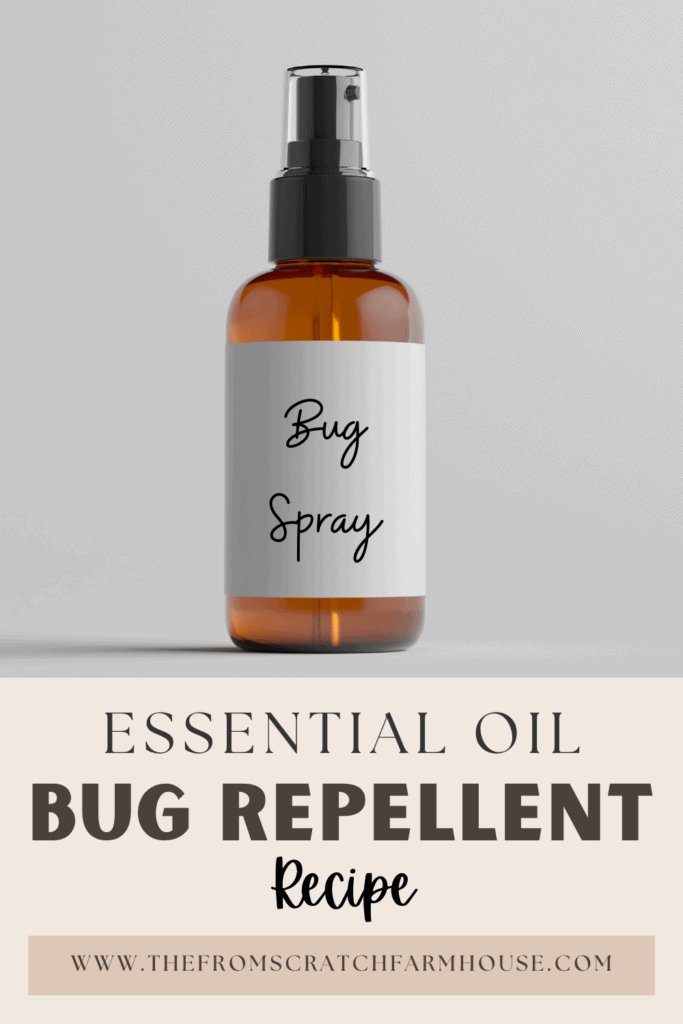
Making your own bug spray is such an easy and effective way to keep pesky insects at bay without exposing yourself to harsh chemicals. By using natural ingredients like essential oils, witch hazel, and distilled water, you can create a bug spray that is safe for you and the environment. So, the next time you head outside, be sure to bring along your homemade bug spray and enjoy the great outdoors without any unwanted visitors!
Looking to make more of your family’s products from scratch? Check out these recipes below!
FAQs
What are the risks associated with chemical-based insect repellents?
Most commercial bug sprays contain several ingredients including DEET and permethrin. Deet is considered “safe and effective” by the CDC and EPA (environmental protection agency), but it is important to understand that it is a chemical pesticide that at full strength will melt plastic! This chemical is absorbed into the skin and bloodstream. Given DEET’s known effects on the central nervous system, this should be cause for concern. DEET is also absorbed into the gut. When we think about the fact that is a pesticide, it’s clear that this could wreak havoc on the gut microbiome.
Permethrin, another commonly used chemical in bug repellents, is also not without risks. This chemical is often used in other applications as a treatment for head lice and scabies. This chemical is also effective in killing bed bugs. Unfortunately, it is also a known endocrine disrupter and is listed by the EPA as a known carcinogen. Some have also reported dizziness, toxic reactions, and behavior problems in children.
Does natural spray actually work?
Yes! I have found this recipe to be very effective. The only downfall is that it must be applied more often. Keep the bottle of spray handy and reapply every 2-3 hours.
With that said, there are some locations where the risks of mosquito bites definitely outweigh the risks of using DEET. If you are in a location where serious diseases cause frequent illness, I would recommend a DEET-based spray that does not contain permethrin. First, cover as much of your skin with clothing that cannot be penetrated by mosquitoes. Then, spray around all openings including arm cuffs, neckline, and pant legs.
Does homemade bug spray have a strong odor?
I personally think it has a great smell, but it definitely is strong. You can certainly add fewer drops of essential oil but for best results, you should make it at full strength.
Is this bug spray safe for pets?
While there has never been an animal study done using this recipe, there are many essential oils that are not safe for pets. Please ask your vet before using this spray on or near your furry friends.
Is this homemade spray safe for sensitive skin?
I don’t necessarily recommend spraying any bug repellent directly on your skin. It is best to spray the mixture along the cuffs of your shirt and pants line. If you need to spray it directly on your skin, test a small patch first.
What should I do if the spray gives me skin rash?
I’ve never seen this spray causes skin rashes, but an alternative way to use it would be to spray it on a cotton ball and place them in shirt and pant pockets.
Should I add a carrier oil to my homemade bug spray?
Some recipes call for carrier oils such as coconut oil or jojoba oil. While these do have properties that are soothing to the skin and can certainly be added, they are not mandatory for making a safe or effective homemade bug spray. If you choose to add this ingredient, 2 teaspoons should be the right amount. Other carrier oils that can be used include avocado oil and olive oil. This can be added before adding the distilled water. Make sure to shake the mixture well before each use, as the oils and water will separate.
Are there natural solutions at my local grocery store?
Thankfully, there are more and more commercial insect repellents that are free of chemicals like DEET and Permethrin. Many of them even use essential oils! Just make sure to check the ingredients carefully. If you don’t know what one of the ingredients is, take the time to do some research before spraying it on or around your loved ones.
My favorite store-bought natural bug spray is a lemon eucalyptus oil-based mixture made by Repel. It does contain some organic chemical compounds, so for a completely natural option, your best bet is to find a homemade product on Etsy.
What is neem oil? Should I add it to my homemade bug spray?
There are mixed thoughts on whether neem oil should be used in homemade bug sprays. I personally didn’t add it because of the risk of irritation if it touches the skin. Neem oil is a great natural bug repellent in the garden, however, and it carries other potential benefits such as its anti-inflammatory properties. If you choose to add it to your recipe, add 1 tablespoon to the given mixture before adding distilled water.
Printable Recipe Card
Homemade Essential Oil Bug Spray Repellent
Equipment
- Funnel
Materials
- 4 oz. glass spray bottle
- 2 oz. witch hazel
- ½ tsp. vegetable glycerin
- 30-40 drops of essential oils adjust according to your desired scent
My favorite essential oils for use as a natural mosquito repellent that also deters ticks:
- 20 drops oil of lemon eucalyptus not recommended for directly applying to children under 3
- 5 drops thyme essential oil
- 5 drops citronella essential oil
- 5 drops lemongrass essential oil
- 2 drops geranium oil
Instructions
- To your 4 oz. bottle, add 2 oz. of witch hazel (I just estimate about halfway up the bottle
- Add ½ tsp. Vegetable glycerin.
- Add the essential oils of your choice.
- Fill the rest of the bottle with distilled water, leaving enough space at the top to shake the mixture.
- Screw the top on tightly and give it a good shake.
- Shake before using. Spray onto clothing, near doorways and windows, and where mosquitoes and ticks may access the skin.
Notes
- Shake the bug spray bottle well before each use to ensure that the ingredients are evenly distributed.
- Store the bug spray in a cool, dark place when not in use.
- Re-apply every 2-3 hours as needed
Did you make this recipe?
Tag us @thefromscratchfarmhouse so we can see your creations! You can also leave a comment below!


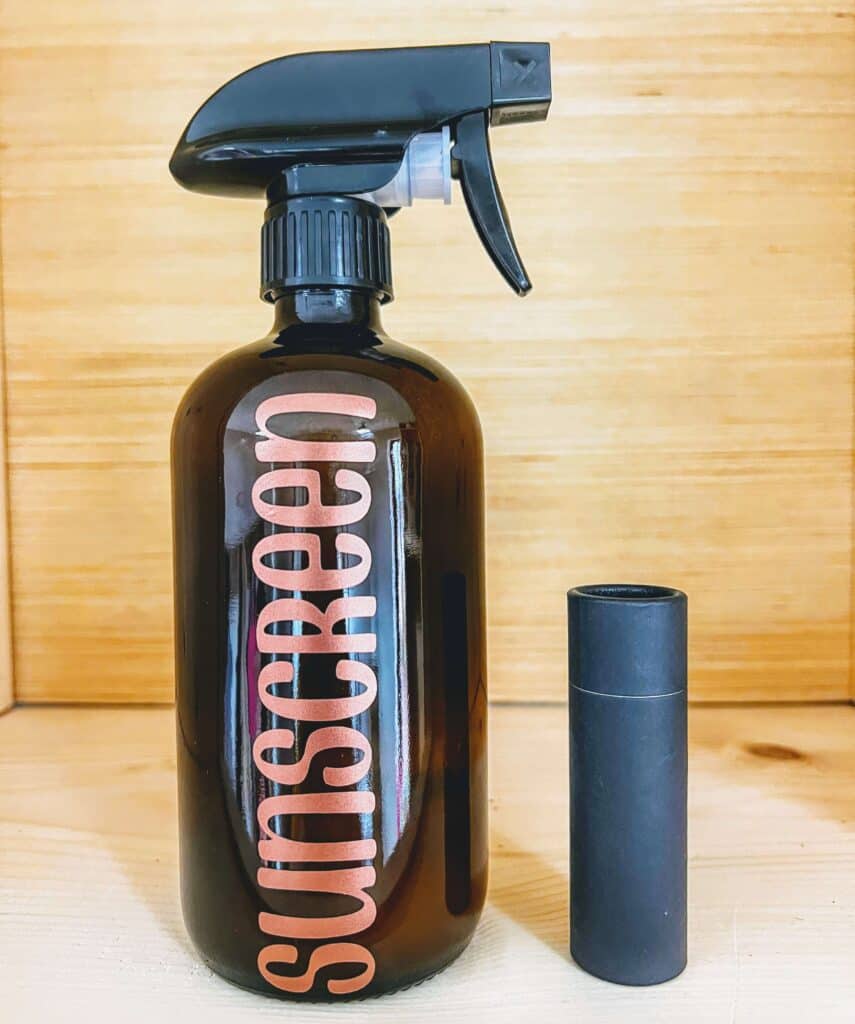
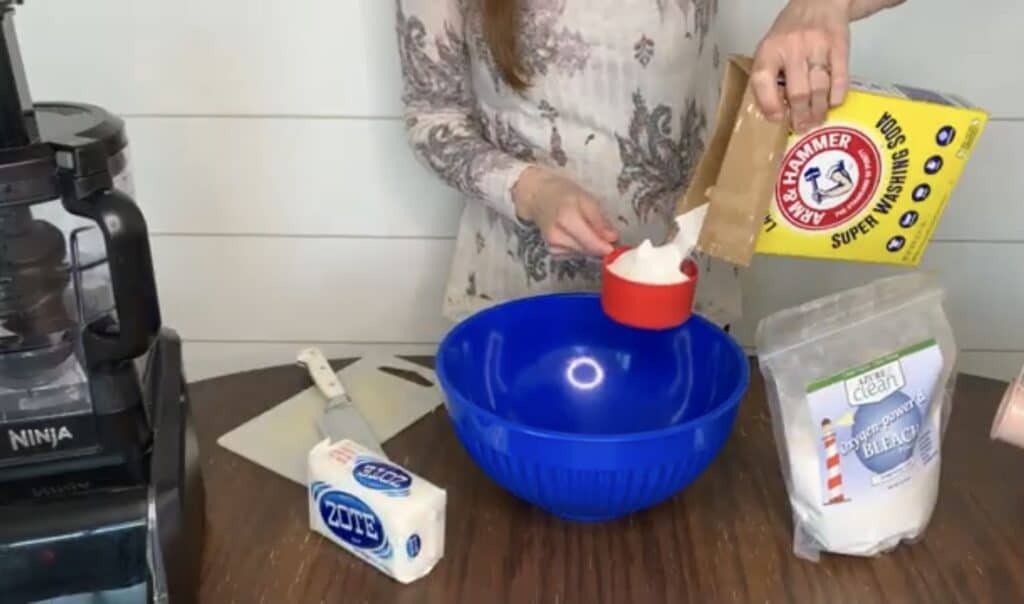
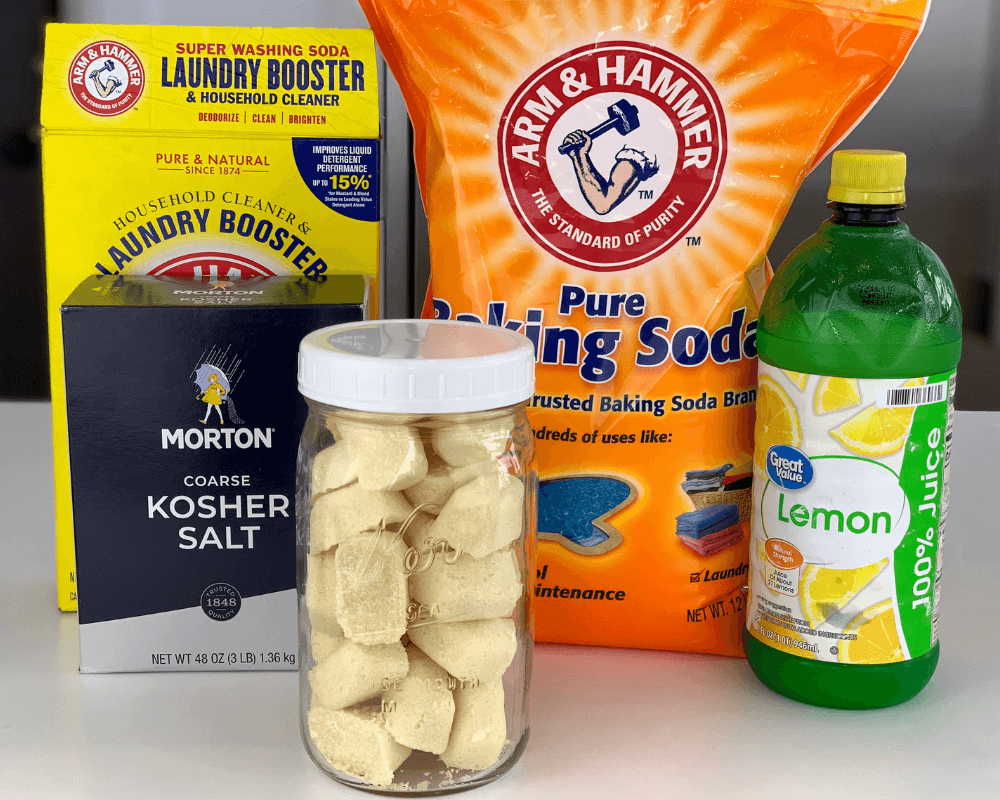
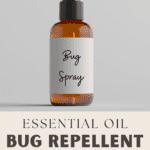
Hello, Thank you for this great recipe! I made it tonight but did not add the vegetable glycerin. Is it a necessary ingredient, and if so, what is it’s purpose?
Thank you!
Bea Ann Bridges
It will be ok without it, but you will have to definitely give it a shake before using. The glycerin mostly helps the ingredients stay emulsified, but it also helps the oils sit on your skin or clothing longer.